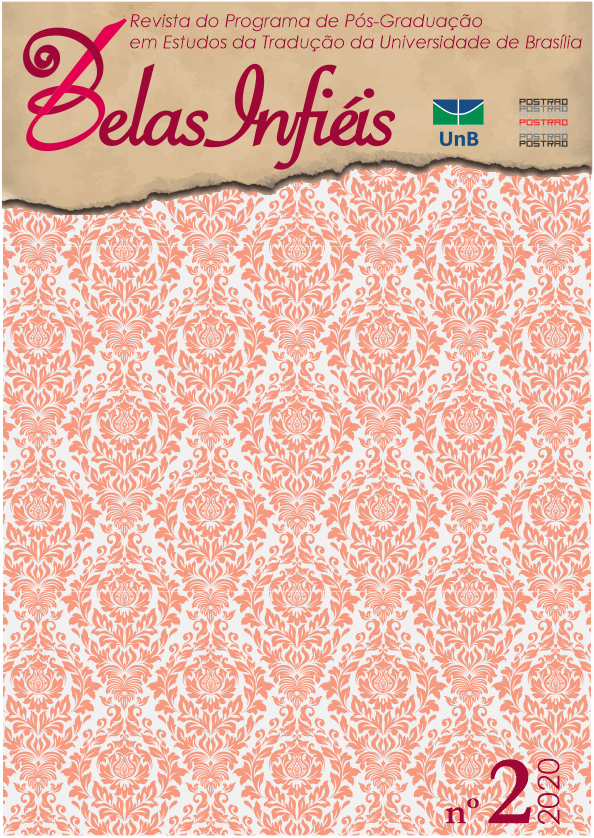Translation of burlesque epic poetry: La Gatomaquia by Lope de Vega
DOI:
https://doi.org/10.26512/belasinfieis.v9.n2.2020.26995Keywords:
Traduction. Poetry. Epic literatura. Burlescliterature. La Gatomaquia.Abstract
This article proposes a brief introduction of the epic-burlesque poem of Félix Lope de Vega, La Gatomaquia (1634), a still secondary piece in the studies about the author, whose extensive bibliography focuses instead on his dramatic work. Two central issues justify this pos-doctoral enterprise: the first is about Lope de Vega´s option of a burlesque genre to end his epic work, after having published long poems that attempted to build in Spain the imaginary of a glorious history, much like Luis de Camões did in Portugal with OsLusíadas (1572). Nevertheless, far from proposing an innovative project, as he had done in El arte nuevo de hacercomedias (1609), which tried to account for a new type of comedy that had been consolidating Spain, Lope makes clear that he belongs in a tradition which is essential for the composition of this jocose poem and whose names include Marcião de Sinope, Diego Hurtado de Mendoza and, specially, Homer. This article aims at analysing, therefore, the references present in the poem and the reach of the burlesque genre in spanish literature. The second issue points towards the still scanty reach of epic spanish poetry in Brazil, which opens up space to a proposal of a commented translation of the poem from castilian to portuguese, aiming at fostering sixteenth-century spanish literature in portuguese-speaking countries. This investigation brings together results from my doctorate thesis, which pointed to the necessity of a critical edition of La Gatomaquia, whose reach would be even bigger with its subsequent translation to portuguese, which would result in a bilingual publication.
Downloads
References
BALCELLS, José María. La Batracomiomaquia y la epopeya burlesca en la Edad de Oro. IX Simposio de la Sociedad Española de Literatura general y comparada. 2, 1994, p. 25-30.
BENJAMIN, Walter. A tarefa do tradutor. Belo Horizonte: UFMG, 2008.
BLÁZQUEZ RODRIGO, Marcelo. La gatomaquia de Lope de Vega. Madrid: Consejo Superior de Investigaciones Científicas, 1995.
CAMPANA, Patrizia. La silva en Lope de Vega. AISA. Actas V, p. 249-260, 1999.
CAMPOS, Haroldo de. Da transcriação: poética e semiótica da operação tradutora. Belo Horizonte: UFMG, 2011.
COLUNGA, Alberto; TURRANO, Laurentio. Biblia sacra: iuxtavulgatanclementinam. Madrid: La Editorial Catolica, 1953.
CONCHADO, Diana. La Gatomaquia de Lope de Vega y la épica burlesca. Moenia. 2, 1997, p. 421-484.
COVARRUBIAS, Sebastián de. Tesoro de la lengua castellana. Madrid: Iberoamericana, 2006.
DAGUT, Menachem. Can “Metaphor” be translated. Babel. 22. p. 21-32, 1976.
DERRIDA, Jacques. “Des tours de Babel” in GRAHAM, Joseph. Difference in Translation. Londres : Cornell University Press, 1985.
DERRIDA, Jacques.Sovereigneities in question: the poetics of Paul Celan. Nova York: FordhamUniversityPress, 2005.
EGIDO, Aurora. La silva en la poesía andaluza del Barroco. Criticón. v. 46, n. 1, p. 5-39, 1989.
ENTRAMBASAGUAS, Joaquín de. Lope de Vega y su tiempo. Barcelona: Labor, 1935.
ESCARPIT, Robert. L’humour. Paris: Presses universitaires de France, 1962.
HÖFFE, Otfried. Aristóteles: Introdução. Porto Alegre: Artmed, 2008.
HUERTA CALVO, Javier. “La teoría de la crítica literaria” in AULLÓN DE HARO, Pedro. Teoría de la crítica literaria. Madrid: Trotta, 1994.
JAKOBSON, Roman. Linguística e comunicação. São Paulo: Perspectiva, 1975.
LUKÁCS, György. Teoría de la novela. Barcelona: Siglo XXI, 1967.
FUMAROLI, Marc. La querelle des anciens et des modernes. Paris, Gallimard, 2001.
MARAVALL, José Antonio. Antiguos y modernos. Madrid: Alianza Editorial, 1965.
MARAVALL, José Antonio. La cultura del Barroco. Barcelona: Ariel, 1980.
MENÉNDEZ PIDAL, Ramón. La epopeya castellana a través de la literatura española. Buenos Aires: Espasa-Calpe, 1945.
MILTON, John. Tradução: teoria e prática. São Paulo: Martins Fontes, 2010.
NIDA, Eugene; TABER, Charles. The theory and practice of translation. Leiden: Brill, 1970.
ORTEGA Y GASSET, José. El libro de las misiones. Madrid: Espasa-Calpe, 1940.
PALLÃ BONET, Julio. Homero en España. Madrid: Alianza, 1953.
PIERCE, Frank. La poesía épica del Siglo de Oro. Madrid: Gredos, 1968.
POUND, Ezra. Literary essays of Ezra Pound. Londres: Faber & Faber, 1960.
PRIETO, Antonio. “Origen y transformación de la épica culta en castellano” in Coherencia y relevancia textual. Madrid: Alhambra, 1980.
QUILIS, Antonio. Métrica española. Madrid: Ediciones Alcalá, 1969.
RICOEUR, Paul. A metáfora viva. Rio de Janeiro: Loyola, 2000.
ROZAS, Juan Manuel. La obra dramática de Lope de Vega. Alicante: Biblioteca Virtual Miguel de Cervantes, 2002.
STEINER, George. After Babel: aspects of language and translation. Oxford: Oxford UniversityPress, 1975.
TORRE, Esteban. Teoría de la traducción literaria. Madrid: Síntesis, 2001.
VÁZQUEZ DE PRADA, Andrés. El sentido del humor. Madrid: Alianza Editorial, 1973.
VEGA, Lope de. La Gatomaquia. Madrid: Fundamentos, 2009 (publicado originalmente em 1634).
VINAY, Jean-Paul; DARBELNET, Jean. Stylistique comparée du français et d l’anglais : méthode de traduction. Paris: Didier, 1972.
Downloads
Published
How to Cite
Issue
Section
License
Given the public access to this journal, the texts are free to use but requires the recognition of the original authorship and initial publication in this journal to be properly stated.
 The journal allows the use of works published for non-commercial purposes, including the right to submit the work to publicly accessible databases. Published contributions are the sole and exclusive responsibility of the author(s).Â



















